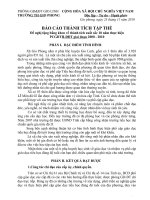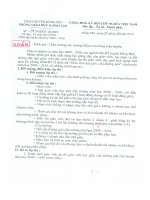Astm d 345 02 (2010)
Bạn đang xem bản rút gọn của tài liệu. Xem và tải ngay bản đầy đủ của tài liệu tại đây (75.15 KB, 3 trang )
Designation: D345 − 02 (Reapproved 2010)
Standard Test Method for
Sampling and Testing Calcium Chloride for Roads and
Structural Applications1
This standard is issued under the fixed designation D345; the number immediately following the designation indicates the year of
original adoption or, in the case of revision, the year of last revision. A number in parentheses indicates the year of last reapproval. A
superscript epsilon (´) indicates an editorial change since the last revision or reapproval.
This standard has been approved for use by agencies of the Department of Defense.
solid forms of calcium chloride for comparison with the
requirements of a specification, such as Specification D98.
1. Scope
1.1 This test method covers sampling of solid and liquid
forms of calcium chloride, and sieve analysis of solid form
calcium chloride. Referee procedures for chemical analysis are
covered in Test Methods E449.
4. Apparatus
4.1 Sampling Equipment:
4.1.1 Sampling Tube—Metal tube, approximately 25 to 40
mm (1 to 11⁄2 in.) diameter, and of appropriate length (500 mm
(20 in.), minimum) for sampling solid-form calcium chloride.
4.1.2 Sampling Bottle—Sampling devices such as described
in Practice D140 for sampling liquid calcium chloride.
4.1.3 Sampling Containers—Glass bottles or semi-rigid
plastic containers with covers with airtight seal for protecting
the samples from time of sampling until the samples ae used in
testing. The containers for solid-form calcium chloride shall
have wide mouths or openings for solid-form calcium chloride.
1.2 A rapid method of chemical analysis is shown in
Appendix X1. This rapid method is not to be used for
determining chemical compliance of calcium chloride with
specification requirements, such as in Specification D98.
1.3 The values stated in SI units are to be regarded as the
standard.
1.4 This standard does not purport to address the safety
concerns, if any, associated with its use. It is the responsibility
of the user of this standard to establish appropriate safety and
health practices and determine the applicability of regulatory
limitations prior to use.
4.2 Sieves, with the size openings required for the test, shall
conform to the requirements of Specification E11.
2. Referenced Documents
4.3 Balances, having a capacity of at least 250 g, shall be
readable to 0.1 g, and shall be accurate to 0.1 g or 0.1 % of the
test load, whichever is greater, at any point within the range of
use.
2
2.1 ASTM Standards:
C136 Test Method for Sieve Analysis of Fine and Coarse
Aggregates
D98 Specification for Calcium Chloride
D140 Practice for Sampling Bituminous Materials
E11 Specification for Woven Wire Test Sieve Cloth and Test
Sieves
E449 Test Methods for Analysis of Calcium Chloride
5. Sampling
5.1 Solid-Form Calcium Chloride:
5.1.1 Package Shipments—Select not less than three containers at random from the shipment. For drums, sample each
of the containers by scraping aside the top layer to a depth of
approximately 25 mm (1 in.) and taking 0.5 kg (1 lb) samples
by means of a sampling tube or other method that will ensure
a sample that is representative of a cross section of the
materials in the container to a depth of at least 150 mm (6 in.).
For bags, take 0.5 kg (1 lb) samples by means of a sampling
tube penetrating at least 300 mm (1 ft) into the bag. For small
containers with capacity not more than 5 kg (10 lb), use the
entire contents of the container.
5.1.2 Bulk Shipments—Select samples from at least three
locations in the shipment. Scrape aside the top layer to a depth
of approximately 300 mm (1 ft). Using a sampling tube, obtain
a sample extending from the cleared surface to at least 50 % of
the depth of the material in the container, or a depth of
3. Significance and Use
3.1 This test method describes procedures to be used for
sampling calcium chloride, and for determining grading of
1
This test method is under the jurisdiction of ASTM Committee D04 on Road
and Paving Materials and is the direct responsibility of Subcommittee D04.31 on
Calcium and Sodium Chlorides and Other Deicing Materials.
Current edition approved Aug. 15, 2010. Published November 2010. Originally
published as D345 – 32 T. Last previous edition approved in 2002 as D345 – 02.
DOI: 10.1520/D0345-02R10.
2
For referenced ASTM standards, visit the ASTM website, www.astm.org, or
contact ASTM Customer Service at For Annual Book of ASTM
Standards volume information, refer to the standard’s Document Summary page on
the ASTM website.
Copyright © ASTM International, 100 Barr Harbor Drive, PO Box C700, West Conshohocken, PA 19428-2959. United States
1
D345 − 02 (2010)
s (see Note 1). Use the sieve sizes necessary to provide the
information required by the specification covering the material,
and such other sizes as necessary to regulate the amount of
material on a sieve, together with a bottom pan and a cover.
Report the sieve analysis on the basis of the grading requirements in Specification D98 or other applicable specification.
approximately 1 m (3 ft), whichever is less. Each sample shall
contain at least 0.5 kg (1 lb) of material.
5.1.3 Use caution during the sampling operation to avoid
exposing the sample unduly to atmospheric moisture. Immediately and thoroughly mix the individual samples to form a
representative composite sample of material and store in a
sealed glass or suitable plastic container.
NOTE 1—It is important that the sieving be completed within approximately 1 min and weighing be completed quickly due to the hygroscopic
nature of calcium chloride. When possible, the sieve analysis should be
performed in an area with low relative humidity.
5.2 Liquid-Form Calcium Chloride, Bulk Shipments or
Storage—Obtain a sample of at least 500 mL (1 pt) from the
bulk shipping container or storage tank or during discharge.
Recirculate the solution in the tank until it is homogenous, then
take one or more samples by means of an appropriate sampling
device.
5.2.1 Use caution during the sampling operation to avoid
exposing the sample unduly to atmospheric moisture. If more
than one sample is taken, immediately and thoroughly mix the
individual samples to form a representative composite sample
of material and store in a sealed glass or suitable plastic
container.
6.2 Chemical Analysis—Determine the chemical composition of the sample using Test Method E449.
7. Precision and Bias
7.1 Sieve Analysis:
7.1.1 Precision—Precision indexes for sieving calcium
chloride have not been determined. Use the precision indexes
of Test Method C136 as a guide for the sieve analysis carried
out under this test method.
7.1.2 Bias—Since there is no accepted reference material
suitable for determining bias for the procedure for measuring
the sieve analysis of calcium chloride, no statement on bias is
being made.
6. Procedure
6.1 Sieve Analysis:
6.1.1 Sieve approximately 200 g of calcium chloride,
weighed to the nearest 0.1 g, in conformance with Method
C136, except that sieving shall be completed within 1 min 65
8. Keywords
8.1 calcium chloride; grading; sampling; sieve analysis
2
D345 − 02 (2010)
APPENDIX
(Nonmandatory Information)
X1. RAPID METHOD OF ANALYSIS FOR CALCIUM CHLORIDE
X1.1. Scope
X1.4.3 Silver Nitrate Solution—0.1 N AgNO3.
X1.1.1 This appendix covers a rapid method for chemical
analysis of calcium chloride.
X1.4.4 Ammonium Hydroxide (NH4OH).
X1.5. Procedure
X1.2. Significance and Use
X1.5.1 Weigh a 20.0 6 0.2 g sample in a weighing bottle.
Add distilled water to solid form calcium chloride to dissolve.
Add sufficient nitric acid (HNO3) (1 + 1) to clear, dilute to
1000 mL in a volumetric flask, and mix thoroughly. Titrate a
10-mL aliquot, containing five to seven drops of the dichlorofluorescein solution as indicator, with 0.1 N silver nitrate
(AgNO3) solution to a pink end point. Use of other suitable
indicators is permitted.
X1.2.1 The procedure for chemical analysis in this appendix
determines total chlorides (CaCl2, MgCl2, NaCl, KCl, etc.)
present in the sample and expresses that value as calcium
chloride.
X1.2.2 This rapid method only determines total chlorides,
and does not guarantee that the chloride is present as calcium
chloride, therefore no material should be accepted or rejected
under this method of analysis. However, when used in conjunction with Test Method E449 on continuing shipments from
a given source, the procedure may be used to determine
changes in the composition of the material being furnished,
especially with regard to moisture content. Thus the frequency
of testing by Test Method E449 may be reduced.
X1.5.2 This procedure is not suitable for testing the material
if more than a slight precipitate of magnesium hydroxide
(Mg(OH)2) appears when a 10 % filtered solution of the
material is made alkaline with ammonium hydroxide
(NH4OH).
X1.6. Calculation
X1.3. Apparatus
X1.6.1 Calculate the total chlorides expressed as percent
CaCl2, C, as follows:
X1.3.1 Glassware—Standard weighing bottles, volumetric
flasks, and burets.
C 5 mL 0.1 N AgNO3 3 2.77
X1.3.2 Balance, as described in 4.3.
(X1.1)
X1.7. Precision and Bias
X1.4. Reagents
X1.7.1 This procedure for chemical analysis is not intended
for precise measurement or determination of specification
compliance. Statements for precision and bias are therefore not
necessary.
X1.4.1 Nitric acid (HNO3), 1 + 1 by volume.
X1.4.2 Dichlorofluorescein—0.1 % aqueous solution of the
sodium salt of dichlorofluorescein.
ASTM International takes no position respecting the validity of any patent rights asserted in connection with any item mentioned
in this standard. Users of this standard are expressly advised that determination of the validity of any such patent rights, and the risk
of infringement of such rights, are entirely their own responsibility.
This standard is subject to revision at any time by the responsible technical committee and must be reviewed every five years and
if not revised, either reapproved or withdrawn. Your comments are invited either for revision of this standard or for additional standards
and should be addressed to ASTM International Headquarters. Your comments will receive careful consideration at a meeting of the
responsible technical committee, which you may attend. If you feel that your comments have not received a fair hearing you should
make your views known to the ASTM Committee on Standards, at the address shown below.
This standard is copyrighted by ASTM International, 100 Barr Harbor Drive, PO Box C700, West Conshohocken, PA 19428-2959,
United States. Individual reprints (single or multiple copies) of this standard may be obtained by contacting ASTM at the above
address or at 610-832-9585 (phone), 610-832-9555 (fax), or (e-mail); or through the ASTM website
(www.astm.org). Permission rights to photocopy the standard may also be secured from the ASTM website (www.astm.org/
COPYRIGHT/).
3









